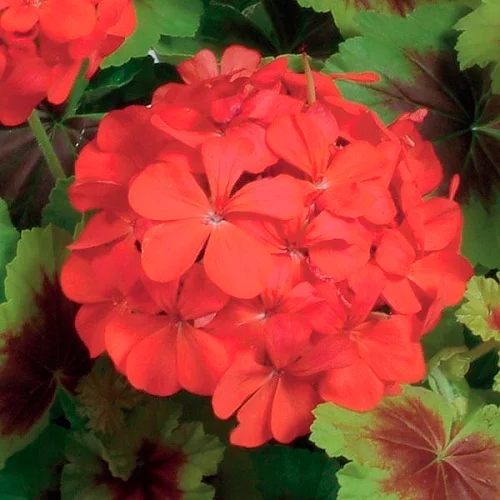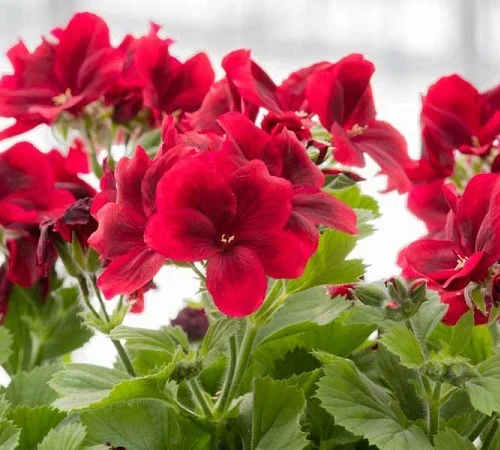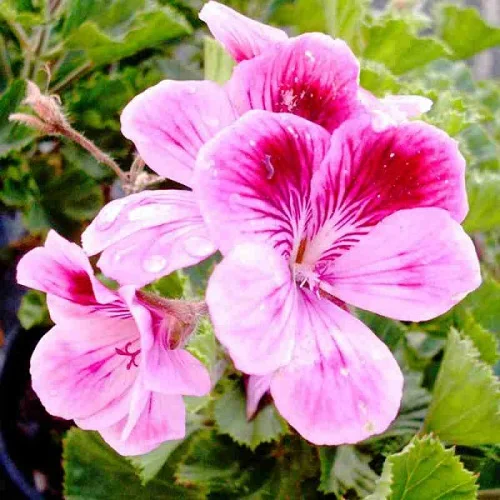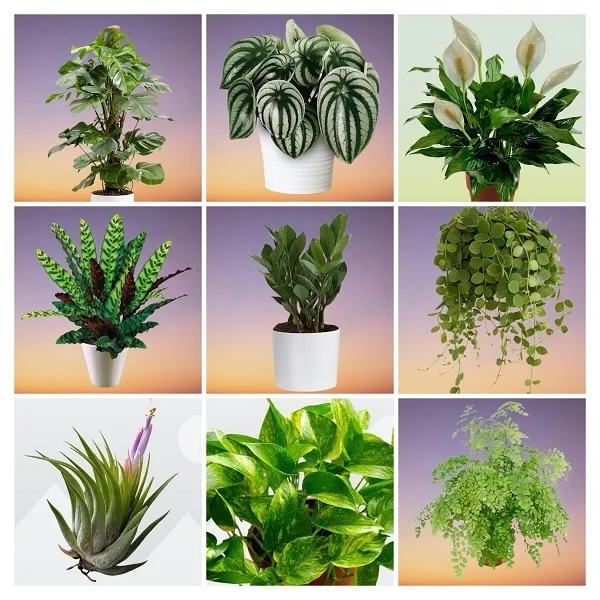How to Grow and Care for Pelargonium x hortorum (Zonal Geraniums) Indoors
Some links in this post may be affiliate links
Pelargonium x hortorum (Zonal Geraniums) thrive in bright light with some direct sunlight, average warmth, average room humidity and consistently moist, rich, well-drained soil coupled with monthly feeding in the growing season.
Zonal Geraniums also called Horseshoe Geraniums or Zonal Pelargonium are some of the popular flowering plants on account of their ease of care, large colourful blooms and long flowering period.
Zonal Pelargonium are sun-loving plants that they will bloom almost all year-round if kept next to a sunny window at an average temperature.

Botanical name: Pelargonium x hortorum
Family: Geraniaceae
Common names: Zonal Geranium, Horseshoe Geranium, Zonal Pelargonium
Origin
Pelargonium x hortorum is a hybrid between Pelargonium zonale and Pelargonium inquinans which are native to South Africa. Pelargonium x hortorum belongs to the group of Pelargoniums called Zonal Pelargonium which refers to the brown annular zone around the leaves.
Size
Pelargonium x hortorum grows to a height of 1-2 feet but some can reach 4 feet or more. On account of their compact size and love for direct sunshine, Zonal Geraniums are some of the best plants for a sunny balcony.
Flower
Pelargonium x hortorum like its relative Pelargonium peltatum (Ivy Geranium) bears large clusters of flowers which come in white, red, pink, orange and purple. The whole plant except the flowers gives off a characteristic smell. Numerous varieties for growing indoors are available.
Is Pelargonium x hortorum toxic?
No. Pelargonium x hortorum are non-toxic to humans and pets. They are known to be used in teas and cakes.
Where to Buy
Zonal Geraniums are a great addition to your collection, you may acquire these plants online from Etsy (Link to Etsy).
How do you care for Pelargonium x hortorum indoors?
To care for Pelargonium x hortorum indoors, give it bright light with 4-6 hours of direct sunlight, average warmth of 18-270C, humidity of 50-55% and consistently moist, fertile, well-drained soil coupled with monthly feeding during the growing season.
Zonal Geraniums care requires regular pruning to keep it neat, discourage pest and disease infestations as well as encourage a bushy compact growth. Repotting is only necessary when the plant is extremely pot-bound as it blooms best when the roots are confined. Keep reading for more on these growing conditions and how best to provide them.

Light requirements
Do Zonal Geraniums like sun or shade?
Zonal Geraniums like bright light with at least 4-6 hours direct sunshine to encourage flowering. Place these plants near a sunny window that receives some morning or late afternoon sunlight. Keep them away from hot midday sun to prevent scorching of the leaves.
The plants will not bloom if the light is not enough. Therefore, where natural light is inadequate, use a full spectrum grow light to supplement it.
Regularly turn the pot to ensure that the plant receives light on all sides for uniform growth and also prevent legginess.
Watering
How do you water Zonal Geraniums?
Water your Zonal Geraniums liberally in spring and summer while allowing the top 1-2 inches of soil to dry out between waterings. Keep the soil moist but not soggy to avoid yellowing and leaf drop.
Decrease watering in fall and winter as growth is minimal at this time but do not allow the soil to dry out completely to prevent wilting and leaf fall.
Use room temperature water to prevent cold shock which can result in stunted growth and leaf loss. Ensure to use chlorine-free water like rain water to prevent brown leaf tips and edges.
Make sure that the pot has a drainage hole to avoid soggy soil as it can lead to root-rot and death of the plant.
Temperature & Humidity
Zonal Geraniums grow best in an average warmth of 18-270C. The cool nights and warm days are necessary to trigger flower buds. Keep them away from drafts as the sudden changes in temperatures can cause reddening leaf edges, leaf drop, wilting and stunted growth.
Pelargonium x hortorum prefer a moderate humidity of 50-55%. If the air is too dry, set the pot on a wet pebble tray or use a humidifier to raise humidity. Do not mist the leaves as it can lead to fungal diseases.
Fertilizer
What is the best fertilizer for Zonal Geraniums?
Feed your Zonal Geranium with a phosphorous-rich, water-soluble fertilizer every 3-4 weeks in spring and summer to enhance flowering.
Withhold feeding in fall and winter as growth is minimal and it can lead to fertilizer burn and eventual death of the plant.
Regularly, leach out the accumulated salts by running a stream of water through the soil until it drains through the drainage hole.
Potting Soil
The best soil for Zonal Geraniums should be at a PH of 6.0 to 6.5, rich in organic matter and well-draining to prevent waterlogging while providing the required nutrients.
Repotting
Repot your Zonal Geranium at the beginning of the growing season (spring to early summer), only when the plant is extremely pot-bound; it blooms more when the roots are confined.
Use a pot 1 size larger and one that has a drainage hole and free-draining soil to avoid root-rot. Check out these pots with drainage holes on Amazon.
Do not repot a plant that is in flower as the repotting shock can shorten the flowering period.
Pruning
Pruning Zonal Geraniums involves:
- Remove dead flowers and leaves to maintain the plant tidy as well as minimize pest and disease infestations. Cut the flowerstalks at the base.
- Pinch off the growing tips at a point above a leaf node to encourage a bushy growth and to prevent the plant from becoming unruly.
- After flowering, lightly cutback the stems to rejuvenate growth and to keep the plant bushy.
How do you keep Pelargonium x hortorum flowering?
- Give it bright light with at least 4-6 hours of direct sunshine.
- Keep the soil consistently moist in spring and summer and slightly moist in fall and winter.
- Use water that is at room temperature to prevent slowed growth.
- Maintain an average warmth of 18-270C and a humidity of 50-55%.
- Pot it in rich, well-draining soil and a pot with a drainage hole to prevent waterlogging.
- Feed it with a phosphorous-rich, water-soluble fertilizer every 3-4 weeks in spring and summer.
- Keep it slightly pot-bound as it blooms best when slightly root-bound.
- Regularly inspect the plant for pests and diseases and carry out timely control measures.
- Maintain the plant well pruned to promote a healthy, lush growth.
Pelargonium x hortorum Propagation
Pelargonium x hortorum propagation is easily done from stem cuttings or by seed germination at the beginning of the growing season (spring to early summer).
Propagating Zonal Geraniums from stem cuttings
- Take a 4-6 inches stem cuttings from a healthy branch. Strip off the lower leaves.
- Fill a small pot with free-draining soil, moisten the soil lightly and make a hole in the center. Ensure the pot has proper drainage to prevent rotting.
- Dip the lower cut end of the cutting in a rooting hormone to encourage rooting.
- Insert 2-3 inches of the cuttings in the previously made hole and firm the soil around it.
- Place the set up in a warm, well-lit spot away from direct sunlight to prevent scorching.
- Maintain the soil moist through out until the new plants are well established after which you can begin routine care.
Germinating Zonal Geraniums seeds
- Fill a seed tray with a well-draining soil and moisten it slightly.
- Spread the seeds evenly on the moist soil and cover lightly with some soil.
- Cover the set up with a plastic sheet to create a greenhouse effect.
- Position the set up in a warm, brightly-lit place away from direct sunlight.
- Maintain the soil moist through out by gently misting the soil surface until the seedlings are well established.
- Once the seedlings appear, remove the plastic cover.
- When the seedlings are a reasonable size, transplant them into individual pots.
- Place the pots in a well-lit spot and maintain the soil moist until the new plants are well established.

Pelargonium x hortorum Problems & Solutions
Pelargonium x hortorum problems are yellow leaves, brown leaves, lack of blooms, leaf drop, leggy growth, pests and diseases. Keep reading for more on these problems and how to solve them.
Yellow leaves
Why do Pelargonium x hortorum leaves turn yellow?
Some of the causes of yellow leaves on Pelargonium x hortorum are inconsistent watering, soggy soil, nutrients deficiency or too little light.
How to fix it
Inconsistent watering: Water when the top 1-2 inches of soil dry out but never allow the soilball to dry out completely. Do not water on a schedule.
Soggy soil: Use a pot with a drainage hole and well-draining soil.
Nutrients deficiency: Feed the plant with a phosphorous-rich, water-soluble fertilizer every 3-4 weeks in spring and summer.
Too little light: Place the plant in bright light with 4-6 hours of direct sunshine or use a grow light is the natural light is not adequate.
Brown leaves
Why are my Pelargonium x hortorum leaves turning brown?
The main causes of brown leaves on your Pelargonium x hortorum are inconsistent watering, soggy soil, salts buildup and temperature stress.
How to fix it
Inconsistent watering: Water when the top 1-2 inches of soil dry out but never allow the soilball to dry out completely. Do not water on a schedule.
Soggy soil: Use a pot with a drainage hole and well-draining soil.
Salts buildup: Regularly, flush out the accumulated salts by running a stream of water through the soil until it comes out through the drainage hole.
Temperature stress: Keep the plant away from drafts coming from AC units, heat sources, windy doors and windows among others.
Lack of blooms
Why are my Pelargonium x hortorum not blooming?
Your Pelargonium x hortorum is not blooming due to too little light, nutrients deficiency, inconsistent watering, soggy soil dry air or temperature stress.
How to fix it
Too little light: Position the plant in bright light with 4-6 hours of direct sunshine or use a grow light is the natural light is not enough.
Nutrients deficiency: Feed the plant with a phosphorous-rich, water-soluble fertilizer every 3-4 weeks in the growing season (spring and summer).
Inconsistent watering: Do not water on a schedule. Water when the top 1-2 inches of soil dry out but never allow the soilball to dry out completely.
Soggy soil: Use a pot with a drainage hole and well-draining soil.
Dry air: Use a wet pebble tray or a humidifier to increase humidity.
Temperature stress: Keep the plant away from drafts emanating from AC units, heat sources, windy doors and windows among others.
Leaf drop
Leaf drop on Pelargonium x hortorum is caused by use of cold water, inconsistent watering, soggy soil or drafts.
How to fix it
Use of cold water: Water the plant with water that is at room temperature to avoid shocking it.
Inconsistent watering: Do not water on a schedule. Water when the top 1-2 inches of soil dry out but never allow the soilball to dry out completely.
Soggy soil: Use a pot with a drainage hole and well-draining soil.
Drafts: Keep the plant away from drafts emanating from AC units, windy doors, drafty windows, heat sources and others.
Leggy growth
Leggy growth on Zonal Geraniums is due to too little light, overwatering or soggy soil.
How to fix it
Too little light: Move the plant to a brighter spot where it will receive bright light with 4-6 hours of direct sunlight or instal a grow light if the natural lighting is not adequate.
Overwatering: Water only when the top 1-2 inches of soil dry out. Do not water on a schedule.
Soggy soil: Ensure that the pot has a drainage hole and the soil is well draining.
Pests
Common pests on Zonal Geraniums are whiteflies, aphids and vine weevil.
How to fix it
- Isolate the affected plant to prevent spread to other plants.
- Treat the infested plant with neem oil or insecticidal soap as per the manufacturers' recommendations.
- Check between and underneath the leaves for these pests and carry out timely control measures.
- Maintain the plant well pruned to discourage the pest infestations.
Diseases
Zonal Geraniums are prone to the following three diseases:
1. Black leg disease which is enhanced by soggy soil. The symptoms are oval, sunken, light-brown to black cankers with purple-to-black margins near the base of the stem.
How to fix it
- Isolate the affected plant to minimize spread to other plants.
- Treat the infected plant with neem oil as instructed by the manufacturer.
- Improve ventilation and make sure that there is free air circulation for the plant.
- Always allow the top half of soil to dry out between waterings.
- Empty excess water from the catch plate and do not allow the plant to sit in soggy soil.
- Make sure that the pot has a drainage hole and that the soil is free-draining.
2. Oedema disease which is promoted by soggy soil. It presents as water-soaked, corky patches on the leaves.
How to fix it
- Isolate the affected plant to reduce spread to other plants.
- Remove and discard the badly affected leaves as they will not recover.
- Move the plant to a brightly-lit spot.
- Reduce the frequency of watering for some time to keep the soil barely dry.
3. Botrytis disease which is associated with soggy soil. It appears as grey mold on the leaves.
How to fix it
- Cut all affected parts and destroy by burning to to prevent spread to other plants.
- Replace the moldy soil with fresh free-draining soil and allow the soil to dry out between waterings.
- Spray the plant with a systemic fungicide. Ensure all the parts of the plant are well covered with the fungicidal solution.
- Avoid wetting the foliage during watering; water from the bottom instead.
- Improve ventilation; ensure there is free air circulation.
You liked it? Share on social media.
Related Content
Amazon Associates Disclosure
Homeplantsguide.com is a participant in the Amazon Services LLC Associates Program, an affiliate advertising program designed to provide a means for sites to earn advertising fees by advertising and linking to amazon.com.





